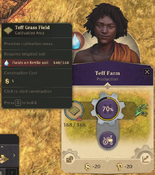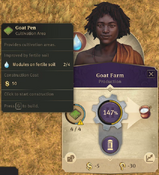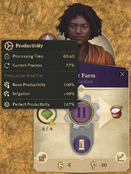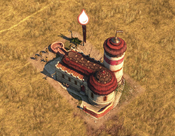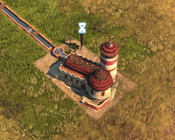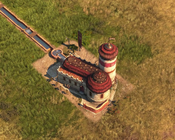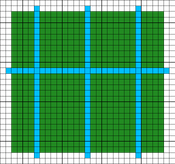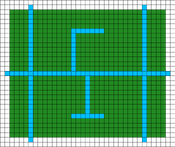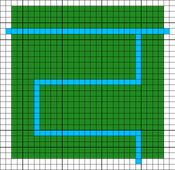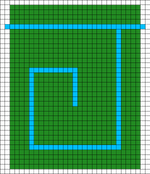Irrigation is a system unique to Enbesa, available in Land of Lions DLC. It is required to make all crop farms and fire stations operational, it is also useful for improving animal farms effectiveness.
Canal system[]
Rivers in Enbesa contain river slots, where water pumps can be placed. Water taken from the rivers has to be distributed via canals, which irrigate the soil within 4 tile radius from each watered canal tile. The land turns from dry and yellowish into lush green area of irrigated soil. Water pumps have limited capacity, each pump can support up to 250 canals. If two water pumps are connected to each other via canals, their irrigation capacity is combined, which lets you build a longer canal than a single pump can support.
The number of river spots on an island is limited, therefore the number of water pumps you can build on each island is also limited. It is necessary to keep in mind that river slots are also required to place clay collectors and paper mills, so it is important to carefully manage and prioritise the use of river slots.
Farms[]
All fields of Enbesan crop farms have to be placed on irrigated soil in order for farms to be productive, crop fields outside of irrigated soil are completely useless and bring no productivity. Animal farms can produce goods without irrigation, however if a module of an animal farm is located on irrigated soil, it contributes twice as much productivity as without irrigation (the tile adjacent to the centre of the module has to be placed on irrigated soil). Main buildings of farms do not have to be located on irrigated soil, only their modules do (only crop or animal modules, not silos or tractor barns).
Fire stations[]
Enbesan fire stations require access to water to be able to extinguish fires. Each fire station has to be connected to the watered canal system. The connection needs to be provided in a specific spot located on one of the shorter sides of the fire station - that's where the canal system has to be connected to the fire station.
Things to keep in mind[]
- River slots are limited so make sure you use them well; consider importing clay to Enbesa to avoid building too many clay collectors
- All crop farms' modules have to be placed on irrigated soil.
- Animal farms don't require irrigation but they are significantly boosted when their modules are placed on irrigated soil. If the capacity of your water pumps is sufficient, try to always place your animal modules within irrigated soil.
- Modules of animal farms can be only partially placed in irrigated soil to profit from access to water - a tile adjacent to the middle of the module has to be irrigated.
- Try not to place any buildings on irrigated soil, only modules of farms have to be built on irrigated soil.
- When planning and creating your canal system, make sure you will be able to reach each spot where a fire station has to be located.
- Your residents don't need water, however the fire stations used to put out fires in houses have to be placed inside or nearby cities and they require access to water.
Exemplary layouts[]
There are many ways of arranging the canal system. There is no single way that would always work due to each island being different, having rivers and river spots in different locations and having some tiles near rivers and lakes already irrigated. However, there are certain strategies of arranging canals that can be used place canals as optimally as possible, to use as few canal tiles while irrigating as big part of the land as possible. Basic layouts such as straight lines, snake and spiral layouts are general examples how canals can be arranged. Branching allows to achieve flexibility, creating branches is a good way to adjust the canal system to any island and to player's individual needs. Crucial thing to remember is that each canal tile can irrigate land in every direction and 4 tiles away from the canal, therefore in order to utilise canals optimally, there should be at least 8 tiles of space between consecutive branches.







